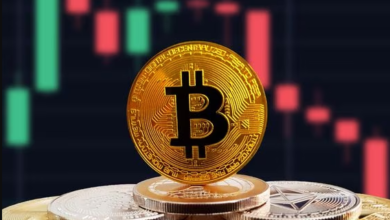What Are the Four Stages of a Business Cycle?

A business cycle is the boom and fall of the economy during a specific time. Economic factors like GDP, employment rate, interest rate, and others are its indicators. These factors help in predicting current stage of the economy. Businesses need to understand the business cycle. It helps in decision-making about investments and other policies. The business cycle has a direct effect on shares, profits, and other earnings of the businesses. The length of a business cycle is not specified. It may vary in different conditions.
The exact cause of this cycle is also not specified as of now. Different schools of economics highlight different causes for this cycle. However, schools of economics agree on four stages of the business cycle. The four stages of the business cycle include expansion, peak, contraction, and trough. Businesses need to arrange their strategies according to this cycle. This correlation helps in surviving and gaining profit throughout different phases of the cycle. The four phases of business Cycles are as follows;
Table of Contents
Expansion:
In this phase, economies experience sharp growth. All economic factors show positive scores. In this phase, businesses start growing and investors start investing with confidence. As their purchasing power increases, their spending increases as well. The inflation rate starts decreasing in this period. Supply and demand are also in balance. It means that the interest rate is also decreasing in this phase. Factories produce more products. The confidence of people in the market also increases as they know that the market has enough supplies to meet their demands. Businesses also invest more amounts in meeting the demands of the market. Interest rates also start decreasing, and people have enough money to pay their debts.
The gross domestic product (GDP) also shows a positive score. This phase also shows a good score of employment. In this exact phase, pay rates also increase within the country. And the unemployment rate decreases. Employers also increase the ranks of their employees. They accommodate them with different allowances. Living standards of people start improving in this phase. Education, health, and law in order start improving as well. Countries start new development projects. They also start investing in infrastructures to support businesses. This situation attracts foreign direct investment (FDI) through increased numbers into the country. This expansion period is essential for everyone.
Peak:
According to a dissertation writing firm, peak is the next phase of the business cycle. It starts when the expansion reaches its highest point. In this phase, countries experience little, or no unemployment. In this phase, economies produce their best results as well. Countries showcase their best GDP rates within this phase. This phase is recognizable only when it’s gone. The GDP rate helps in recognizing this phase. This peak is also a point where manufacturers produce at their best. It means that they are no more able to meet the market’s demand. They have no capacity to improve any further. The difference between demand and supply may take the economy towards inflation. Competitors also start outperforming one another. The economy essentially has no more space to grow.
Contraction:
Contraction phase is a mirror of the expansion phase. In this phase, unemployment starts increasing, and employers start laying off their employees. GDP of the country also starts decreasing in this phase. As unemployment increases, their purchasing power starts decreasing as well. Purchases of the goods that go higher in the peak phase may not be affordable for many anymore. The living standard of people also starts decreasing and they don’t have enough money to maintain high living standards. People start losing confidence.
They don’t know what is going to happen and take back their money out of the stocks. The foreign investors don’t show any interest regarding further investments. In these situations, governments stop working on mega projects. People start facing difficulties to meet their necessities. A study shows that the 2008 recession significantly increased the rate of suicides within the US (Demirci, 2020). They faced difficulty in meeting their health and education expenses. Another study shows that the people of Greece were not able to meet their healthcare requirements during the recession crisis (Zavras, 2020).
Trough:
The trough phase is a mirror of the peak phase. In this phase, all negative scores reach their peak level. This period is also the end of the recession. After this phase, things start improving again. During this phase, the economy experiences a high rate of unemployment. This unemployment also increases the inflation rate to its peak. Because of this, people lose their confidence. They face severe economic conditions and try to survive in such difficult times. The crime rate also increases in this phase. A country’s GDP reaches its lowest level during this phase. This phase is also recognizable with the lowest GDP rate.
The interest rate also reaches its highest level. People may not be able to pay their taxes or rents. The number of homeless people also increases in this phase. Before the economy starts moving towards expansion, people experience a tough time. They start losing their vision, and try to earn bread and butter for their survival. If GDP remains at the lowest level for the fiscal quarter, this phase is called an economy’s depression phase.
Conclusion:
The economy of a country fluctuates between the periods of expansion and contraction. The business cycle may vary from country to country. GDP and employment rate are some factors that recognize the phase of the business cycle. Understanding the business cycle helps businesses in future stability. Ignorance of the business cycle may cause a huge loss for businesses. Economists have different opinions about its causes. Expansion is the first phase of this cycle, and economies enjoy growth within it. Things start moving positively, and the employment rate starts improving.
The living standard of people also improves in this phase. In the peak phase, economic growth reaches its peak level. Economies have no more capacity to grow, so they start turning back. In the contraction phase, all positive numbers start converting into negative ones. Unemployment and interest rates also start increasing. Trough is the last phase of this cycle. It is the point where all negative numbers reach their worst level. After this, they start moving towards the expansion phase. Economies experience both boom and recession, and this cycle keeps moving throughout its different phases.




